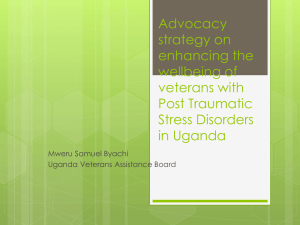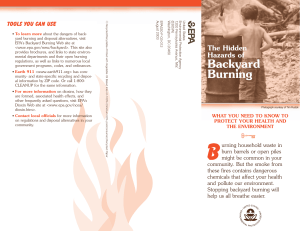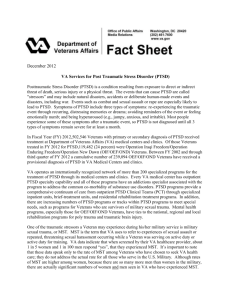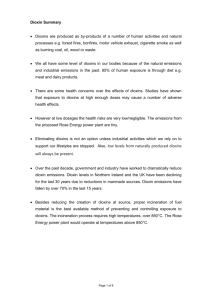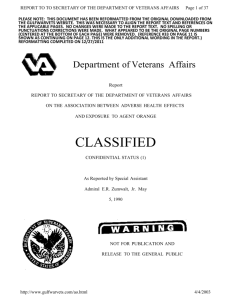View a Power Point Presentation of the Healing
advertisement
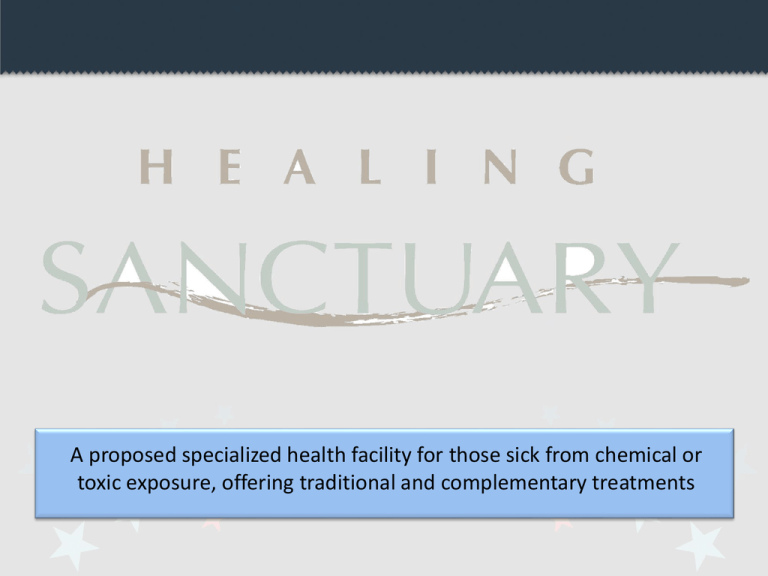
A proposed specialized health facility for those sick from chemical or toxic exposure, offering traditional and complementary treatments Remember Rally Organization • Remember Rally is a 501c3 Non-Profit Organization • Since 2003, volunteers have held fundraisers to honor military & the 9/11 rescue workers Vietnam/Agent Orange Called Agent Orange because of the color of the bands around the 55 gallon drums, the defoliant contained dioxins and classified as a human carcinogen, builds up and persists in tissues for years, even decades. • Over 22 million gallons of Agent Orange were sprayed to ‘defoliate’ Viet Nam • 80% of the herbicide was sprayed between 1962-1971 • It was applied by airplanes, helicopters, trucks and backpack sprayers • The spray soaked the soldiers, their clothes and food • It occurred in all four military zones Vietnam/Agent Orange • Dioxin is a compound found in Agent Orange and has been shown to be a carcinogen • The exposure to Dioxins multiplies the chances of cancers, immune system disorders, liver problems, and more. • The Veterans Administration and the government has acknowledged 46 cancers and sicknesses related to Agent Orange Dioxins • Some diseases include: Multiple myeloma, Hodgkin’s disease, nonHodgkin’s lymphoma, chloracne, Diabetes Mellitus Type II, Prostate cancer, respiratory cancers, soft-tissue sarcoma, Spina Bifida, and more • 700,000 military personnel served in this war • 30% of those served suffer from chronic multi-symptom illnesses A 2009 study showed that neurotoxins such as anti-nerve agent pills, insect repellent and the nerve agent sarin caused neurological changes to the brain, and these changes seem to correlate with different symptoms. Symptoms include chronic headache, widespread pain, memory and concentration difficulties and digestive abnormalities. Possible adverse health effects may come from exposure to sarin nerve gas, depleted uranium, anthrax, pyridostigmine bromide, and the botulinum vaccine Signs of undiagnosed illnesses related include: fatigue, headache, muscle or joint pain, neurological symptoms, signs involving the upper or lower respiratory, sleep disturbances, dermatological disorders, gastrointestinal symptoms, abnormal weight loss, neuropsychological symptoms, memory and concentration problems It took 6 years, 8 months to build the World Trade Center and it took 102 minutes to destroy the towers • 9-11 was the largest disaster on United States soil • Almost 3,000 people were killed • Estimated temperature of the fires burning were 1800 degrees F • Some of the dust was as caustic as drain cleaner • It is estimated that there was 90,000 liters of benzene, 400 tons of asbestos, 130,000 gallons of PCBs, and 20,000 gallons of jet fuel 9-11 created a variety and combination of chemicals that people have not been exposed to before. Some contaminants include: Lead, Asbestos, Dioxin, fiberglass, PCBs, Silica, Cadmium, Mercury, concrete dust, burning jet fuel, PAHs, Chromium, Benzene and more. A total of 287 chemicals or chemical groups. Approximately 250,000-400,000 people were exposed to the toxic plume at the World Trade Center Symptoms of those exposed include: Asthma, reduced lung capacity, headache, World Trade Center cough, RADS, chest tightness, acid reflux, depression, anxiety, oral and skin lesions, memory loss, Sarcoidosis, Bronchitis, heart disease, alcohol and substance abuse, and various cancers. The cancer rate is 15% higher than normal for 911 responders. Hundreds of rescue workers have already died from exposure to a multitude of toxins 35,000-60,000 rescue workers & volunteers served at Ground Zero and the Fresh Kills Landfill. Within 48 hours of the attack, the Fire Department found about 90% of its workers reported an acute cough According to the WTC Health Registry, there are now people sick in all 50 states Balad, Iraq, home to what may have been the largest military burn pit, was about the size of 10 football fields. In 2007, Army and Air Force health inspectors went to Balad and measured airborne, cancer-causing dioxins at 51 times the ‘acceptable levels’. The burn pits, smoking landfills, typically contained damaged Humvees, unexploded ordnance, gas cans, mattresses, plastics, medical waste and amputated body parts, batteries, oil and tires. Some of the burn pits burned 24 hours a day, seven days a week. The black plume caused respiratory problems, headaches and other health issues. Troops have inhaled microscopic dust particles laden with toxic metals, bacteria and fungi which ranges from 1991 with the Gulf War to current tours. A registry has been created for U.S. service members perhaps sickened or killed by burn pits used throughout Iraq and Afghanistan. Dust particles, up to 1,000 of which can sit on the head of a pin, gathered in Iraq and Kuwait contained 37 metals. Some metals have been linked to neurological disorders, cancer, respiratory ailments, depression and heart disease. The dust contains 147 different kinds of bacteria, as well as fungi that could spread disease. PTSD (Post Traumatic Stress Disorder) According to the Department of Veterans Affairs 502,546 veterans received treatment at VA medical clinics in fiscal year 2012 for primary or secondary diagnosis of PTSD. PTSD is considered one of the wars’ costliest disabilities. Since September 11, 2001, 2.2 million service members have deployed to war. Some Vets have served two, three, four and even five tours. In addition to injuries and PTSD, there are long-term impacts of hearing loss and traumatic brain injuries. At the Joint Pathology Center in Maryland, Researchers are investigating an important medical issue: whether shrapnel embedded in the bodies of U.S. soldiers can cause chronic health problems. Many veterans, after suffering injuries from roadside bombs during their tours of duty, carry these fragments in their bodies for life. Often surgery is risky, or the fragments in their bodies are too small to remove. Either way, the metallic bits may slowly disintegrate, entering the blood and reaching vital organs. Military doctors first became concerned about embedded shrapnel following the Gulf War in the early 1990’s when they suspected that depleted uranium from tank munitions was causing kidney damage. In 2008 the U.S. Department of Veterans Affairs set up a program to monitor adverse health effect from more than a dozen metals-including lead, copper, and cadmium-found in the urine of over 8,000 shrapnel victims. A proposed specialized health facility for those sick from chemical or toxic exposure, offering traditional and complementary treatments Diane Sherwood, President Remember Rally, Inc. 404 E. Oakland Ave. Luverne, MN 56156 (507) 283-4194 promos@iw.net www.youtube.com/ user/rememberrally







